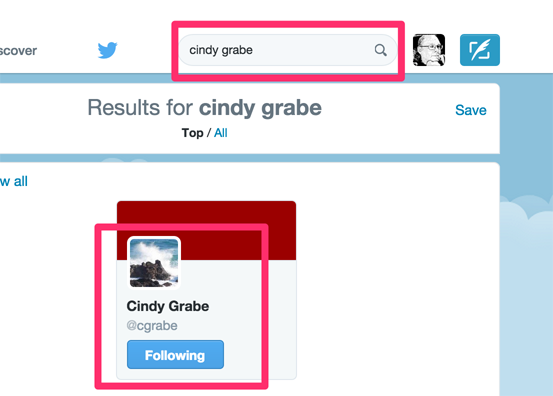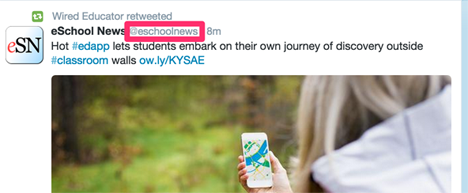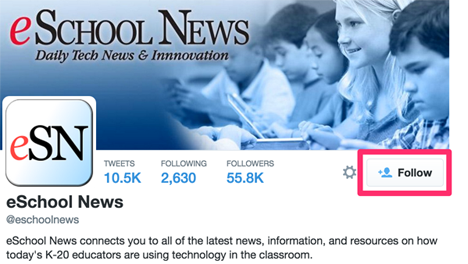Group Microblog (Continued)
Connecting With Users - Forming Your Own Community
Using Twitter as a Component of a Personal Learning Network
The idea of a personal learning network is that as an individual you connect to people and resources that can help you identify useful information, answer your questions, and encourage your reflection. Twitter could represent one of the more interactive components of such a network.
To establish a productive a network, you have to be proactive. You might just start posting tweets and hope what you somehow attracts followers. It does not seem that most microbloggers function in a way that makes this a very useful approach. Full length blog posts contain detailed information and lengthy analysis that attracts attention from popular search engines. Microblog posts can be searched, but the value in microblogging is more in the connections among individuals.
The strategy I would recommend is to use the network to build your network. One reasonable approach is to use the search field that appears at the top of the Twitter page to search for individuals you know to be influential in your field. You might also use "Search" to locate specific tweets on topics that interest you and then identify the author of that tweet. In the following example, I am searching for "Cindy Grabe", you might search other technology using educators you know.

If the search returns hits, identify the @name (@cgrabe in this case). In my example, @cgrabe functions as a link and takes you to Cindy's profile page. Here you find the button you would click to follow Cindy and have her tweets appear in your Twitter stream. Note I am already following Cindy so the button says "following" rather than "follow".

Before you become a follower, a better strategy is to examine the information appearing on the profile page. A quick examination of this content should give you an idea of whether you want to become a follower. Images are also associated with tweets you locate through search.
Once you have located a few individuals to follow, you can begin to take advantage of their networks. Many of us who use Twitter "retweet" valuable tweets from those we follow. You can take advantage of these tweets to explore the content generated by new people and to "follow" those who generate content that appears interesting to you. Identify the @name associated with a tweet and this will take you to the profile page.


Hopefully, the intent of this strategy is becoming apparent. Explore the interests of individuals and follow those you think will offer you useful and interesting information. This approach and the lack of direct interaction necessary to secure access to the wide range of comments offered by others may seem a little creepy. Perhaps it should and this insight may be helpful in any decisions you make to involve students. However, there are some additional factors to consider. As described previously, any Twitter user makes a decision whether comments will be offered to the public. Second, as a Twitter user, you are informed when someone has requested to follow you. At that point, you can elect to "block" the potential follower. You can also elect to reciprocate the interest of a follower and follow that individual. Getting blocked seems a rare experience, but many elect not to follow a large proportion of those who follow them. This is understandable - the amount of information that comes at you can be immense and it is difficult to interact when this volume makes it impractical to locate and follow topics as they emerge.
By the way, as you explore Twitter as a PLN, you will likely use the "Block" option yourself. Try not to conceptualize this as an "ego" thing although it possibly is for some people. Add and delete to generate a flow of ideas and interactions that suit your needs.
How do I or my students learn from microblogging?
Personal Learning Network (PLN)
Here are some ideas you might apply as a professional in support of your own learning. These appear in no particular order.
Turn a reception-oriented experience into an interactive experiene.
Often, those who are using their laptops during a class or presentation are characterized as being off-task. For example, they may be doing their email rather than listening to the presentation. If you were the instructor, you may have wondered what students were actually doing huddled behind their laptops while you were attempting to engage the class in your presentation or a discussion. If you are one of those students, you know.
What if many of the individuals listening to a presentation were using a tool such as Twitter to interact with each other in reaction to what the presenter says? There are situations in which this does happen. Imagine attending the "keynote" presentation at a large conference in which several thousand educators are listening to the same presentation. At most conferences I attend, this is a common situation. Many in the audience are using their laptops to communicate with each other. I am not going to claim that all of the comments are positive, but my point is that there is a lot of interaction going on.
If you are an active microblogger, it is likely that others among the group you follow will attend the same conferences as you. This is a thing that happens when professionals share a common interest. If I open my microblog during a major presentation I can nearly always count on reading a stream of comments. The stream of comments can easily be expanded by searching the name of the conference or perhaps even the name of the presenter. Many conferences now encourage a standard "tag" be used to make it easier to find conference-related posts, tweets, images, and any other material associated with the conference.
What I have described to this point is a synchronous way to augment the experience of listening to a presentation. This scenario extends the experience for those who are physically present. There are several variations on this scenario. A common reality is that one may be interested in the happenings that occur at a given professional meeting, but be unable to physically attend. It is common to follow what is happening remotely but in real time. You may hear the term "live blog" associated with the practice of offering a summary of an on-going presentation to others. Following the comments of multiple live bloggers is an interesting way to experience presentations at a distance. Of course, this experience does not have to happen in real time. A record of the presentation is preserved in the comments and can be explored after the fact. I suppose the presenter could even search for such comments.
It is my impression that while common within certain settings (education conferences) and among certain individuals (educators with an interest in technology) what I have just described would presently be rare in classroom settings. At the college level, there are certainly many large class settings and many students who own laptops. Yet, such activity seems rarely to occur spontaneously. Perhaps instructors need to introduce and support such activities.
Search - please answer my question
Attempts to find answers to user defined questions represent one of the most common uses of the Internet. Search engines offer all of us a convenient and powerful way to find specific information within the vast body of information stored online. You are likely quiet familiar with accessing this body of information.
You may be less experienced accessing the knowledge held by other users of the Internet. A mature network of followers collectively holds a great amount of knowledge. Existing members of such a network have likely cultivated this group because of shared interests and if you share this commonality there is a concentrate of knowledge relevant to your information needs available.
So, a microblog offers the opportunity to ask a question or seek a recommendation. Are there open source programs for editing video? What camcorder do you recommend in the $200-250 range? Perhaps your network contains members with experiences appropriate to such questions. It is probably fair to say that the reaction to such questions is partly determined by the previous history of the group of individuals making up your network. Do members of the group make use of the group to seek information? Are you a visible member of the network who has offered assistance to others?
Discovery - maybe someone will say something interesting
The distinction between search and discover makes sense to me. I admit this distinction is not an original idea, but I no longer know who should receive credit.
We search for information when we realize that there is something we need to know. We can ask a question of the Internet by using a search engine. We can ask a question of a Twitter group. In either case, we are guiding the search for information and our input influences the content we can then access.
In contrast, we sometimes stumble across resources that after examination we recognize as useful or interesting. This process can be passive - watch enough television and one will encounter an occasional item that has personal relevance. However, one might take a more active approach to change the odds of success or the efficiency of the time you spend. Hang out with people with common interests and the discussion is likely to surface interesting ideas. You could ask questions of this group, but you could also follow or interact in response to the flow of the discussion and encounter (discover) useful information.
Hopefully, you can anticipate how a group microblog offers a great opportunity to discover relevant content. Group microblogs have the potential to send a great number of posts (tweets) your way. Just how much information depends on the number of individuals you follow and the frequency with which these individuals post. If you want, you can keep your microblog client active and check each post as it arrives. If you feel the need to attend immediately, some clients have an audible signal that announces the arrival of each new post. You can also activate your client every few hours and scan the new posts. Either approach is bound to offer the opportunity for discovery - links to web resources that may be of interest; a positive comment on a new software program, camera, or new book; the name of an individual you might try to listen to at an upcoming conference. There is also a lot of stuff that is of no great value, but is simply the banter that is part of group interaction. It is up to you to select from this constant flow of content something to think about or investigate further.
Hopefully, it goes without saying that if everyone were a lurker, someone who sits back and waits for others to offer comments and recommendations, there would be no stream of information to follow. While I can't say that I have ever taken the time to drop individuals I follow who offer nothing for the group, some actions are simply not worth the effort, it only seems fair to make an effort to contribute.
Classroom Microblogging
Educators considering class (group) microblogging might want to consider the capabilities of this tool in contrast with other tools available to them and attempt to identify productive activities especially suited to the unique characteristics of microblogging. Other writers might explore potential applications using a different logic, but since our writing examines a wide range of participatory tools an exploration of the unique advantages of individual tools may be of more value.
Here is a list of characteristics that might be used as a point of departure. These characteristics may determine whether a group microblog is the most appropriate tool for an educational task or which microblog service is best suited to a givemn task.
Group sharing - descriptive terminology such as one to many, many to many is sometimes used to describe participatory web tools. How group microblogs should be categorized is complicated and may vary with the specific application. We would argue that Twitter, for example, is most accurately described as a one to many application, i.e., each user relates to a group. Users tend to turn it into a form of many to many because they follow many of the same individuals. For classroom situations (even if sharing with others), you really want a many to many application. As we noted previously, some classroom instructors have found ways to do this even with Twitter (create an account to be used by all students). Group sharing offers a convenient way to distribute content.
Ease of use - microblogs tend to emphasize ease of use. Again, Twitter is a good example because it focuses on basic text messages. Ease of use does come at a price. I would describe this price as user modification. There is no scripting or markup language as would be the case in a wiki or full featured blog. You may not be able to do things like insert images or video. The advantage of ease of use is in the time to become competent with the technology.
Flexibility - having just commented on ease of use as a consequence of limited user modification, it may seem contradictory to note that group microblogs can offer multiple capabilities. Continuing in our use of Twitter as an example, Twitter offers both an approach that allows a tweet to be sent to all followers and an approach that allows a message to be sent to a single follower. This combination of communication options may offer just the set of tools needed for certain projects.
Search - the capability of examining stored content for specific information is important when a system streams a great deal of information and when it is impractical to constantly monitor incoming information. Systems may differ in how or if aged content can be retrieved.
Access - microblogs often allow access from multiple devices. Some are interested in "smart phones" as alternatives to computers and as a way to extend access to more locations.
Some classroom tasks/activities that seem suited to a group microblog:
Extend communication opportunities beyond the school day or class period.
- access after school day / weekends
- access after class has ended
Extend communication opportunities beyond the physical limits of classroom/school.
- access from home
- communication with parents
- communication with students in other schools
- offer comments to class from a distance - special trips, conferences
- communicate with a "guest"
Provide accessible reminders/updates
- assignments, assignment due date, etc.
- changes in practice schedules
Collect information through brainstorming, polling, request for examples
- generate a collection of web links on a topic
- how has your class used Twitter